Operational and Project Management: A Case Study of XYZ Company
VerifiedAdded on 2020/12/09
|15
|4169
|160
Report
AI Summary
This report provides a comprehensive analysis of XYZ Company's operational and project management strategies. It begins with an introduction to operational and project management, emphasizing their significance in business functions. Task 1 reviews and critiques the implementation of operational management principles within XYZ Company, highlighting key principles like reality, organization, and accountability. Task 2 presents a continuous improvement plan, focusing on quality enhancements for XYZ's new product line. Task 3 details a Project Life Cycle (PLC) plan, including a business case, project plan, and work breakdown structure. Task 4 assesses the effectiveness of the PLC in project application. The report integrates relevant theories, such as Six Sigma methodology and Lean principles, to provide a holistic view of operational and project management practices. The conclusion summarizes the key findings and recommendations for XYZ Company.
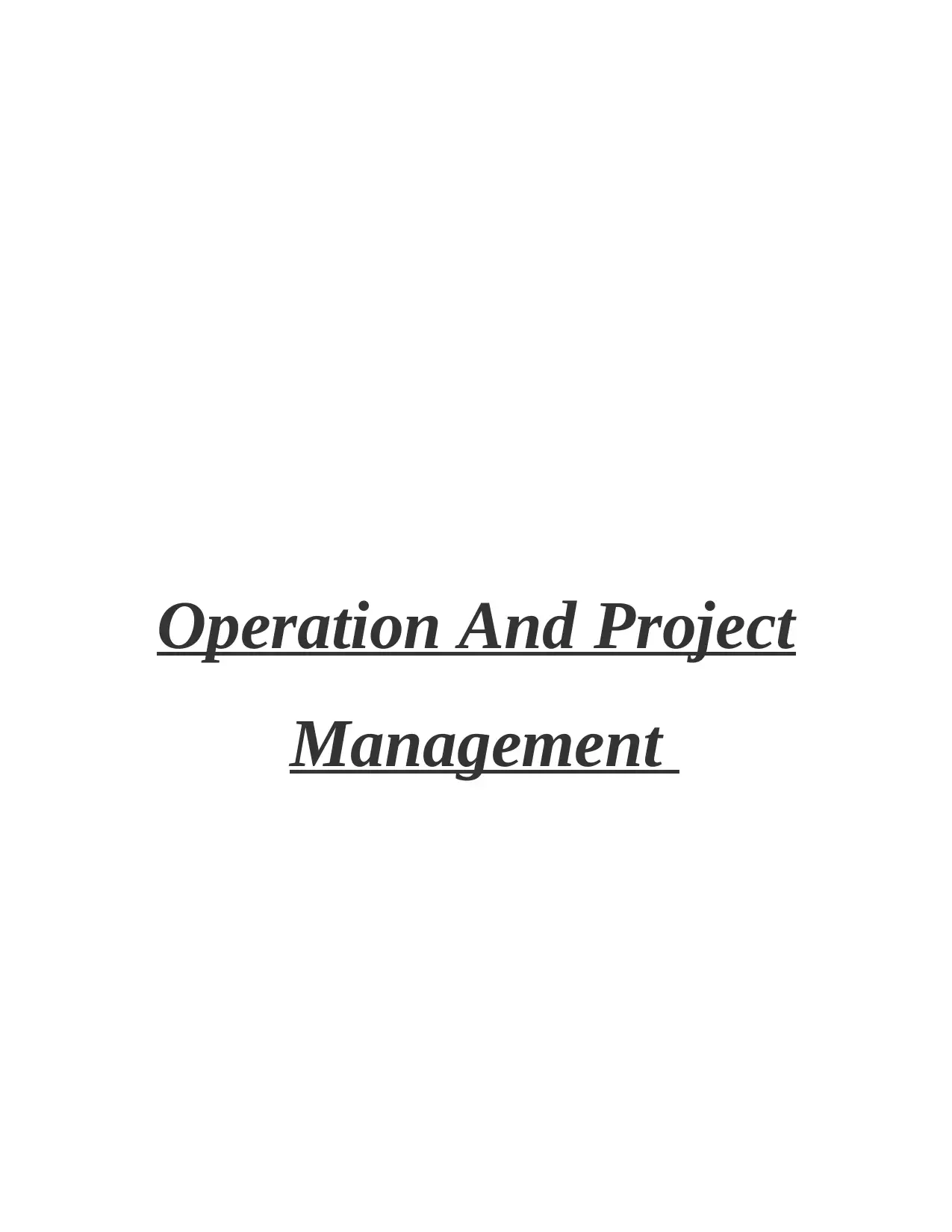
Operation And Project
Management
Management
Paraphrase This Document
Need a fresh take? Get an instant paraphrase of this document with our AI Paraphraser
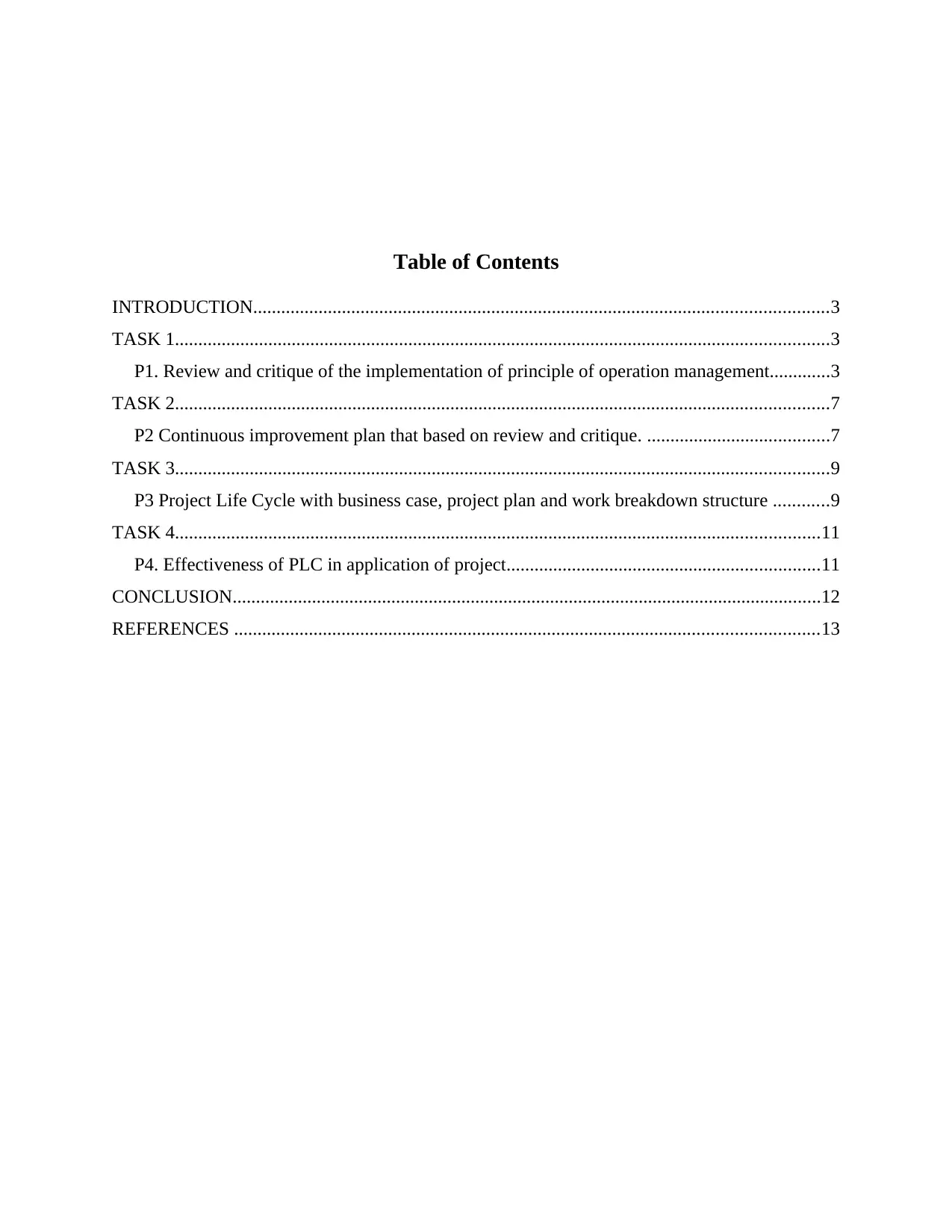
Table of Contents
INTRODUCTION...........................................................................................................................3
TASK 1............................................................................................................................................3
P1. Review and critique of the implementation of principle of operation management.............3
TASK 2............................................................................................................................................7
P2 Continuous improvement plan that based on review and critique. .......................................7
TASK 3............................................................................................................................................9
P3 Project Life Cycle with business case, project plan and work breakdown structure ............9
TASK 4..........................................................................................................................................11
P4. Effectiveness of PLC in application of project...................................................................11
CONCLUSION..............................................................................................................................12
REFERENCES .............................................................................................................................13
INTRODUCTION...........................................................................................................................3
TASK 1............................................................................................................................................3
P1. Review and critique of the implementation of principle of operation management.............3
TASK 2............................................................................................................................................7
P2 Continuous improvement plan that based on review and critique. .......................................7
TASK 3............................................................................................................................................9
P3 Project Life Cycle with business case, project plan and work breakdown structure ............9
TASK 4..........................................................................................................................................11
P4. Effectiveness of PLC in application of project...................................................................11
CONCLUSION..............................................................................................................................12
REFERENCES .............................................................................................................................13
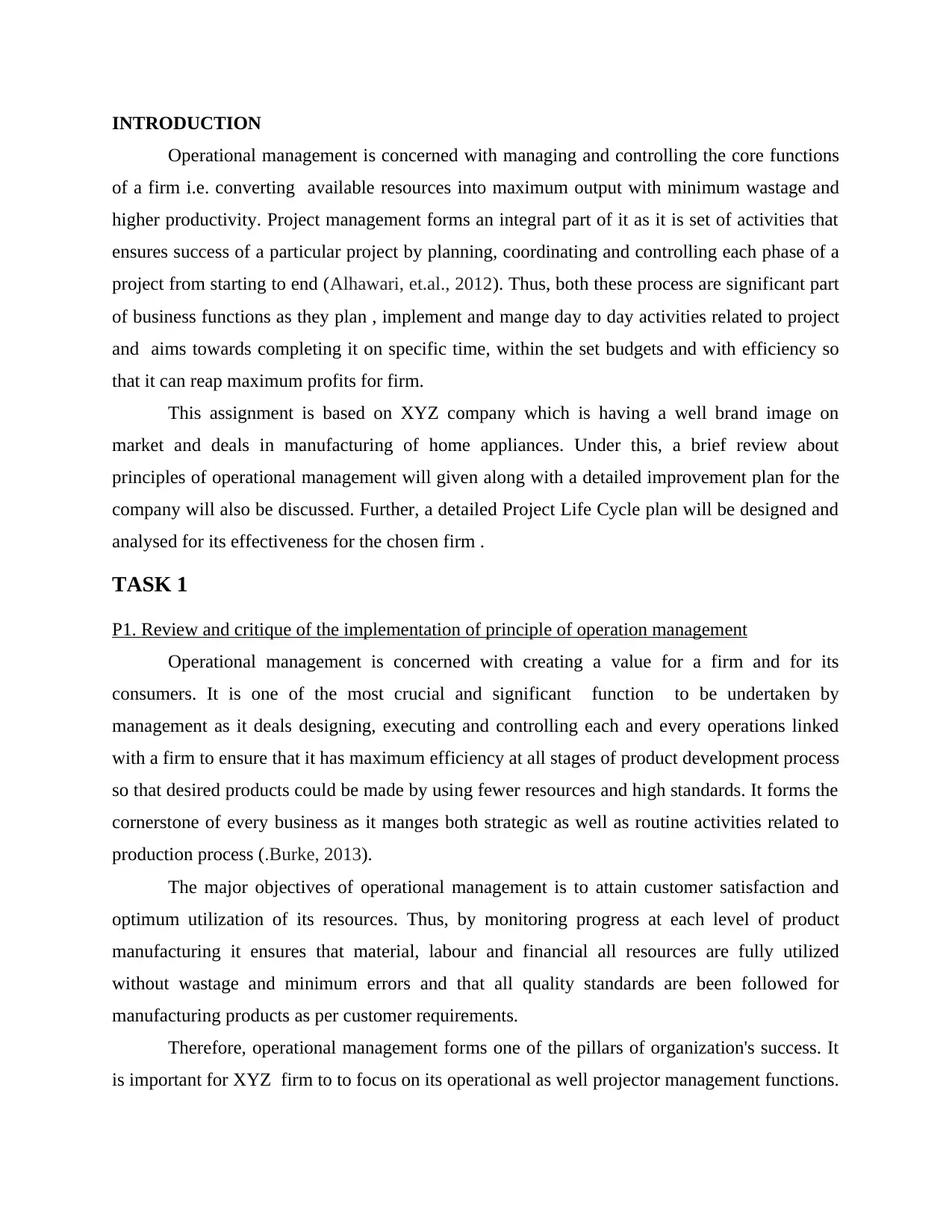
INTRODUCTION
Operational management is concerned with managing and controlling the core functions
of a firm i.e. converting available resources into maximum output with minimum wastage and
higher productivity. Project management forms an integral part of it as it is set of activities that
ensures success of a particular project by planning, coordinating and controlling each phase of a
project from starting to end (Alhawari, et.al., 2012). Thus, both these process are significant part
of business functions as they plan , implement and mange day to day activities related to project
and aims towards completing it on specific time, within the set budgets and with efficiency so
that it can reap maximum profits for firm.
This assignment is based on XYZ company which is having a well brand image on
market and deals in manufacturing of home appliances. Under this, a brief review about
principles of operational management will given along with a detailed improvement plan for the
company will also be discussed. Further, a detailed Project Life Cycle plan will be designed and
analysed for its effectiveness for the chosen firm .
TASK 1
P1. Review and critique of the implementation of principle of operation management
Operational management is concerned with creating a value for a firm and for its
consumers. It is one of the most crucial and significant function to be undertaken by
management as it deals designing, executing and controlling each and every operations linked
with a firm to ensure that it has maximum efficiency at all stages of product development process
so that desired products could be made by using fewer resources and high standards. It forms the
cornerstone of every business as it manges both strategic as well as routine activities related to
production process (.Burke, 2013).
The major objectives of operational management is to attain customer satisfaction and
optimum utilization of its resources. Thus, by monitoring progress at each level of product
manufacturing it ensures that material, labour and financial all resources are fully utilized
without wastage and minimum errors and that all quality standards are been followed for
manufacturing products as per customer requirements.
Therefore, operational management forms one of the pillars of organization's success. It
is important for XYZ firm to to focus on its operational as well projector management functions.
Operational management is concerned with managing and controlling the core functions
of a firm i.e. converting available resources into maximum output with minimum wastage and
higher productivity. Project management forms an integral part of it as it is set of activities that
ensures success of a particular project by planning, coordinating and controlling each phase of a
project from starting to end (Alhawari, et.al., 2012). Thus, both these process are significant part
of business functions as they plan , implement and mange day to day activities related to project
and aims towards completing it on specific time, within the set budgets and with efficiency so
that it can reap maximum profits for firm.
This assignment is based on XYZ company which is having a well brand image on
market and deals in manufacturing of home appliances. Under this, a brief review about
principles of operational management will given along with a detailed improvement plan for the
company will also be discussed. Further, a detailed Project Life Cycle plan will be designed and
analysed for its effectiveness for the chosen firm .
TASK 1
P1. Review and critique of the implementation of principle of operation management
Operational management is concerned with creating a value for a firm and for its
consumers. It is one of the most crucial and significant function to be undertaken by
management as it deals designing, executing and controlling each and every operations linked
with a firm to ensure that it has maximum efficiency at all stages of product development process
so that desired products could be made by using fewer resources and high standards. It forms the
cornerstone of every business as it manges both strategic as well as routine activities related to
production process (.Burke, 2013).
The major objectives of operational management is to attain customer satisfaction and
optimum utilization of its resources. Thus, by monitoring progress at each level of product
manufacturing it ensures that material, labour and financial all resources are fully utilized
without wastage and minimum errors and that all quality standards are been followed for
manufacturing products as per customer requirements.
Therefore, operational management forms one of the pillars of organization's success. It
is important for XYZ firm to to focus on its operational as well projector management functions.
⊘ This is a preview!⊘
Do you want full access?
Subscribe today to unlock all pages.

Trusted by 1+ million students worldwide
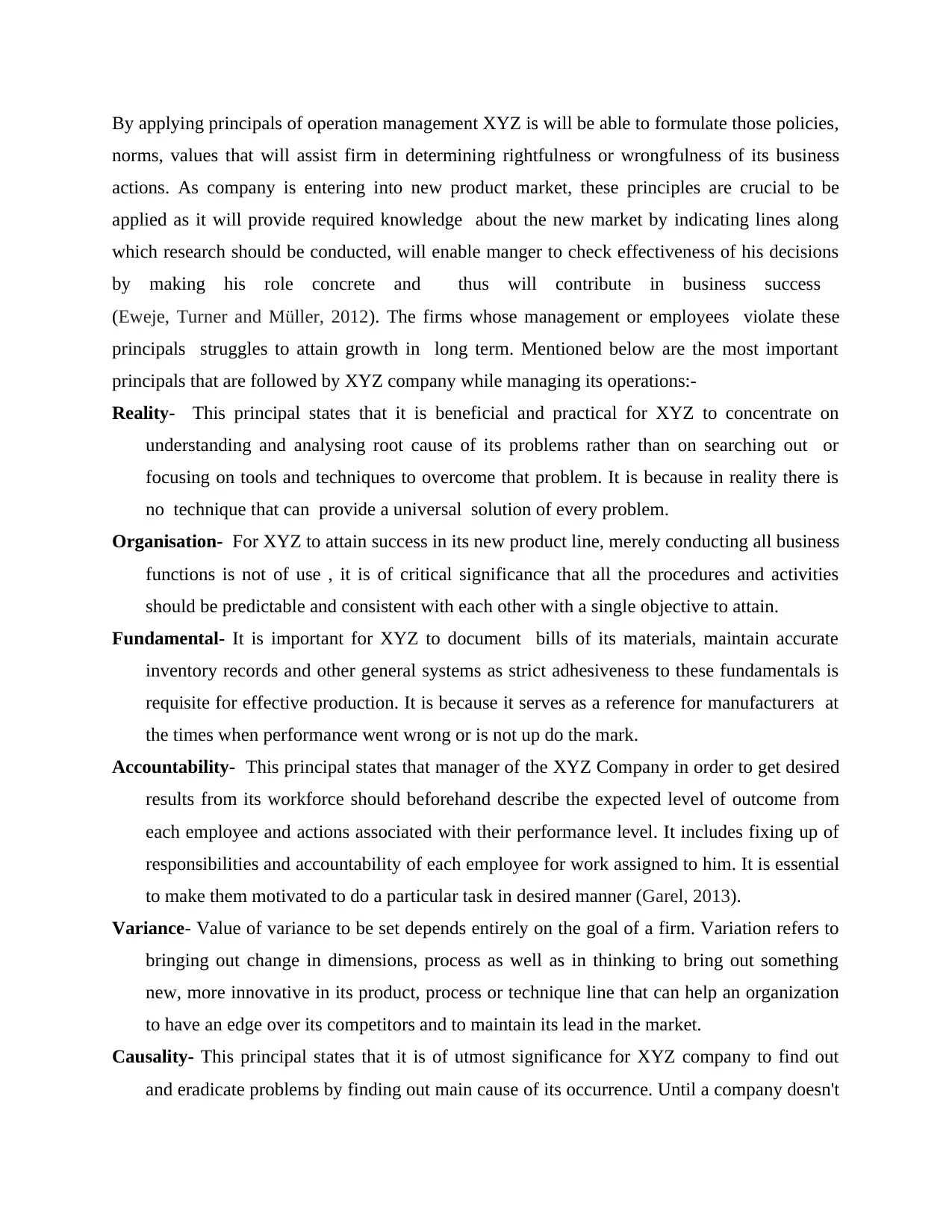
By applying principals of operation management XYZ is will be able to formulate those policies,
norms, values that will assist firm in determining rightfulness or wrongfulness of its business
actions. As company is entering into new product market, these principles are crucial to be
applied as it will provide required knowledge about the new market by indicating lines along
which research should be conducted, will enable manger to check effectiveness of his decisions
by making his role concrete and thus will contribute in business success
(Eweje, Turner and Müller, 2012). The firms whose management or employees violate these
principals struggles to attain growth in long term. Mentioned below are the most important
principals that are followed by XYZ company while managing its operations:-
Reality- This principal states that it is beneficial and practical for XYZ to concentrate on
understanding and analysing root cause of its problems rather than on searching out or
focusing on tools and techniques to overcome that problem. It is because in reality there is
no technique that can provide a universal solution of every problem.
Organisation- For XYZ to attain success in its new product line, merely conducting all business
functions is not of use , it is of critical significance that all the procedures and activities
should be predictable and consistent with each other with a single objective to attain.
Fundamental- It is important for XYZ to document bills of its materials, maintain accurate
inventory records and other general systems as strict adhesiveness to these fundamentals is
requisite for effective production. It is because it serves as a reference for manufacturers at
the times when performance went wrong or is not up do the mark.
Accountability- This principal states that manager of the XYZ Company in order to get desired
results from its workforce should beforehand describe the expected level of outcome from
each employee and actions associated with their performance level. It includes fixing up of
responsibilities and accountability of each employee for work assigned to him. It is essential
to make them motivated to do a particular task in desired manner (Garel, 2013).
Variance- Value of variance to be set depends entirely on the goal of a firm. Variation refers to
bringing out change in dimensions, process as well as in thinking to bring out something
new, more innovative in its product, process or technique line that can help an organization
to have an edge over its competitors and to maintain its lead in the market.
Causality- This principal states that it is of utmost significance for XYZ company to find out
and eradicate problems by finding out main cause of its occurrence. Until a company doesn't
norms, values that will assist firm in determining rightfulness or wrongfulness of its business
actions. As company is entering into new product market, these principles are crucial to be
applied as it will provide required knowledge about the new market by indicating lines along
which research should be conducted, will enable manger to check effectiveness of his decisions
by making his role concrete and thus will contribute in business success
(Eweje, Turner and Müller, 2012). The firms whose management or employees violate these
principals struggles to attain growth in long term. Mentioned below are the most important
principals that are followed by XYZ company while managing its operations:-
Reality- This principal states that it is beneficial and practical for XYZ to concentrate on
understanding and analysing root cause of its problems rather than on searching out or
focusing on tools and techniques to overcome that problem. It is because in reality there is
no technique that can provide a universal solution of every problem.
Organisation- For XYZ to attain success in its new product line, merely conducting all business
functions is not of use , it is of critical significance that all the procedures and activities
should be predictable and consistent with each other with a single objective to attain.
Fundamental- It is important for XYZ to document bills of its materials, maintain accurate
inventory records and other general systems as strict adhesiveness to these fundamentals is
requisite for effective production. It is because it serves as a reference for manufacturers at
the times when performance went wrong or is not up do the mark.
Accountability- This principal states that manager of the XYZ Company in order to get desired
results from its workforce should beforehand describe the expected level of outcome from
each employee and actions associated with their performance level. It includes fixing up of
responsibilities and accountability of each employee for work assigned to him. It is essential
to make them motivated to do a particular task in desired manner (Garel, 2013).
Variance- Value of variance to be set depends entirely on the goal of a firm. Variation refers to
bringing out change in dimensions, process as well as in thinking to bring out something
new, more innovative in its product, process or technique line that can help an organization
to have an edge over its competitors and to maintain its lead in the market.
Causality- This principal states that it is of utmost significance for XYZ company to find out
and eradicate problems by finding out main cause of its occurrence. Until a company doesn't
Paraphrase This Document
Need a fresh take? Get an instant paraphrase of this document with our AI Paraphraser
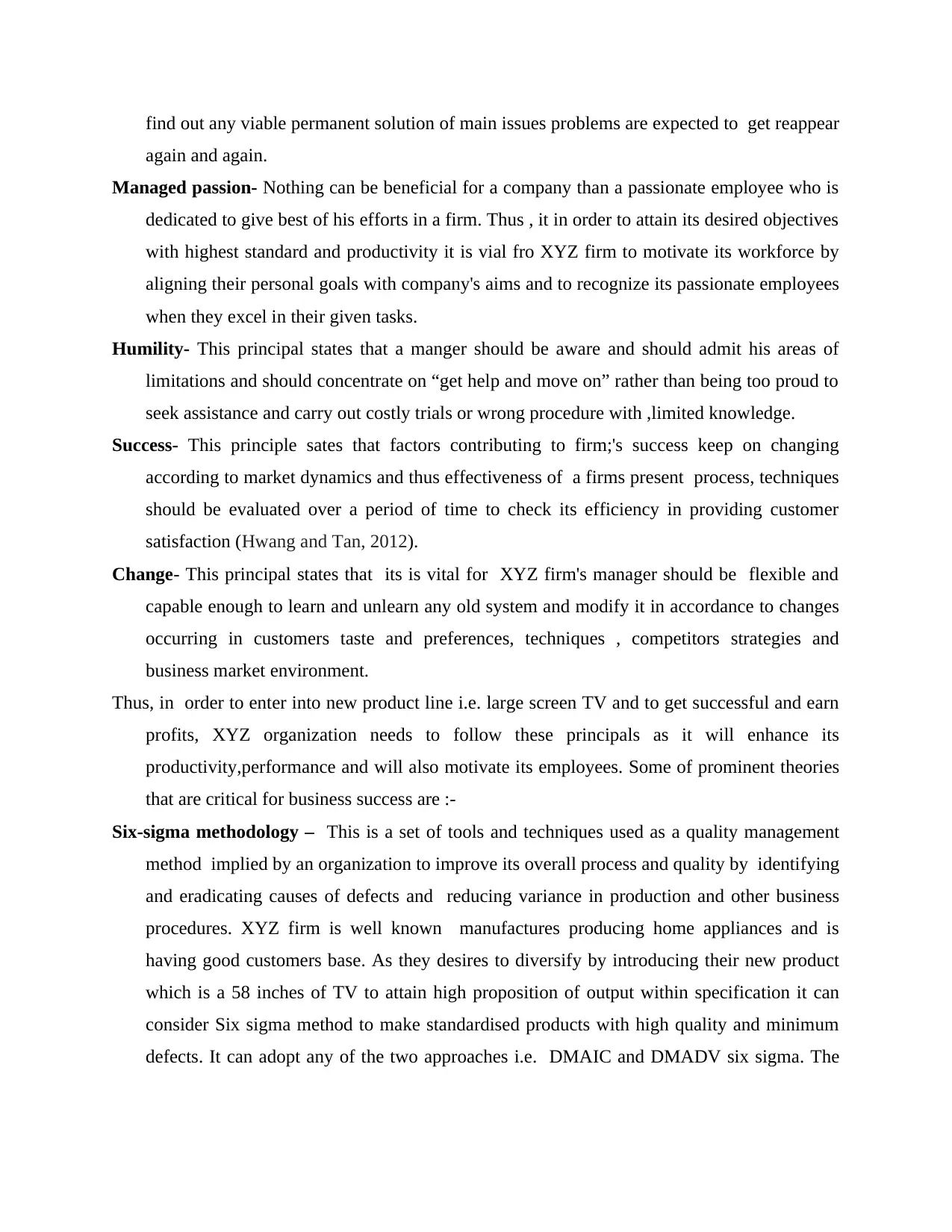
find out any viable permanent solution of main issues problems are expected to get reappear
again and again.
Managed passion- Nothing can be beneficial for a company than a passionate employee who is
dedicated to give best of his efforts in a firm. Thus , it in order to attain its desired objectives
with highest standard and productivity it is vial fro XYZ firm to motivate its workforce by
aligning their personal goals with company's aims and to recognize its passionate employees
when they excel in their given tasks.
Humility- This principal states that a manger should be aware and should admit his areas of
limitations and should concentrate on “get help and move on” rather than being too proud to
seek assistance and carry out costly trials or wrong procedure with ,limited knowledge.
Success- This principle sates that factors contributing to firm;'s success keep on changing
according to market dynamics and thus effectiveness of a firms present process, techniques
should be evaluated over a period of time to check its efficiency in providing customer
satisfaction (Hwang and Tan, 2012).
Change- This principal states that its is vital for XYZ firm's manager should be flexible and
capable enough to learn and unlearn any old system and modify it in accordance to changes
occurring in customers taste and preferences, techniques , competitors strategies and
business market environment.
Thus, in order to enter into new product line i.e. large screen TV and to get successful and earn
profits, XYZ organization needs to follow these principals as it will enhance its
productivity,performance and will also motivate its employees. Some of prominent theories
that are critical for business success are :-
Six-sigma methodology – This is a set of tools and techniques used as a quality management
method implied by an organization to improve its overall process and quality by identifying
and eradicating causes of defects and reducing variance in production and other business
procedures. XYZ firm is well known manufactures producing home appliances and is
having good customers base. As they desires to diversify by introducing their new product
which is a 58 inches of TV to attain high proposition of output within specification it can
consider Six sigma method to make standardised products with high quality and minimum
defects. It can adopt any of the two approaches i.e. DMAIC and DMADV six sigma. The
again and again.
Managed passion- Nothing can be beneficial for a company than a passionate employee who is
dedicated to give best of his efforts in a firm. Thus , it in order to attain its desired objectives
with highest standard and productivity it is vial fro XYZ firm to motivate its workforce by
aligning their personal goals with company's aims and to recognize its passionate employees
when they excel in their given tasks.
Humility- This principal states that a manger should be aware and should admit his areas of
limitations and should concentrate on “get help and move on” rather than being too proud to
seek assistance and carry out costly trials or wrong procedure with ,limited knowledge.
Success- This principle sates that factors contributing to firm;'s success keep on changing
according to market dynamics and thus effectiveness of a firms present process, techniques
should be evaluated over a period of time to check its efficiency in providing customer
satisfaction (Hwang and Tan, 2012).
Change- This principal states that its is vital for XYZ firm's manager should be flexible and
capable enough to learn and unlearn any old system and modify it in accordance to changes
occurring in customers taste and preferences, techniques , competitors strategies and
business market environment.
Thus, in order to enter into new product line i.e. large screen TV and to get successful and earn
profits, XYZ organization needs to follow these principals as it will enhance its
productivity,performance and will also motivate its employees. Some of prominent theories
that are critical for business success are :-
Six-sigma methodology – This is a set of tools and techniques used as a quality management
method implied by an organization to improve its overall process and quality by identifying
and eradicating causes of defects and reducing variance in production and other business
procedures. XYZ firm is well known manufactures producing home appliances and is
having good customers base. As they desires to diversify by introducing their new product
which is a 58 inches of TV to attain high proposition of output within specification it can
consider Six sigma method to make standardised products with high quality and minimum
defects. It can adopt any of the two approaches i.e. DMAIC and DMADV six sigma. The
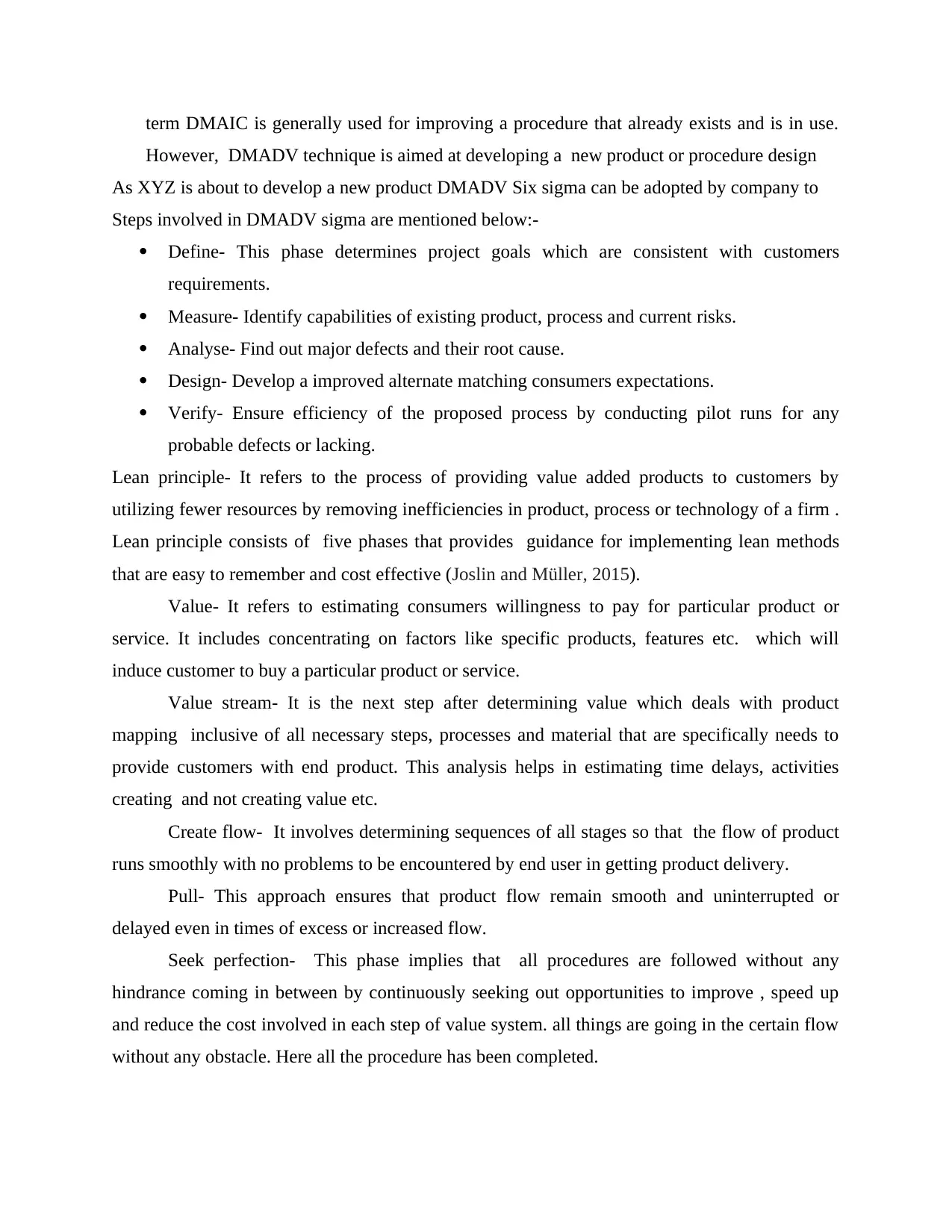
term DMAIC is generally used for improving a procedure that already exists and is in use.
However, DMADV technique is aimed at developing a new product or procedure design
As XYZ is about to develop a new product DMADV Six sigma can be adopted by company to
Steps involved in DMADV sigma are mentioned below:-
Define- This phase determines project goals which are consistent with customers
requirements.
Measure- Identify capabilities of existing product, process and current risks.
Analyse- Find out major defects and their root cause.
Design- Develop a improved alternate matching consumers expectations.
Verify- Ensure efficiency of the proposed process by conducting pilot runs for any
probable defects or lacking.
Lean principle- It refers to the process of providing value added products to customers by
utilizing fewer resources by removing inefficiencies in product, process or technology of a firm .
Lean principle consists of five phases that provides guidance for implementing lean methods
that are easy to remember and cost effective (Joslin and Müller, 2015).
Value- It refers to estimating consumers willingness to pay for particular product or
service. It includes concentrating on factors like specific products, features etc. which will
induce customer to buy a particular product or service.
Value stream- It is the next step after determining value which deals with product
mapping inclusive of all necessary steps, processes and material that are specifically needs to
provide customers with end product. This analysis helps in estimating time delays, activities
creating and not creating value etc.
Create flow- It involves determining sequences of all stages so that the flow of product
runs smoothly with no problems to be encountered by end user in getting product delivery.
Pull- This approach ensures that product flow remain smooth and uninterrupted or
delayed even in times of excess or increased flow.
Seek perfection- This phase implies that all procedures are followed without any
hindrance coming in between by continuously seeking out opportunities to improve , speed up
and reduce the cost involved in each step of value system. all things are going in the certain flow
without any obstacle. Here all the procedure has been completed.
However, DMADV technique is aimed at developing a new product or procedure design
As XYZ is about to develop a new product DMADV Six sigma can be adopted by company to
Steps involved in DMADV sigma are mentioned below:-
Define- This phase determines project goals which are consistent with customers
requirements.
Measure- Identify capabilities of existing product, process and current risks.
Analyse- Find out major defects and their root cause.
Design- Develop a improved alternate matching consumers expectations.
Verify- Ensure efficiency of the proposed process by conducting pilot runs for any
probable defects or lacking.
Lean principle- It refers to the process of providing value added products to customers by
utilizing fewer resources by removing inefficiencies in product, process or technology of a firm .
Lean principle consists of five phases that provides guidance for implementing lean methods
that are easy to remember and cost effective (Joslin and Müller, 2015).
Value- It refers to estimating consumers willingness to pay for particular product or
service. It includes concentrating on factors like specific products, features etc. which will
induce customer to buy a particular product or service.
Value stream- It is the next step after determining value which deals with product
mapping inclusive of all necessary steps, processes and material that are specifically needs to
provide customers with end product. This analysis helps in estimating time delays, activities
creating and not creating value etc.
Create flow- It involves determining sequences of all stages so that the flow of product
runs smoothly with no problems to be encountered by end user in getting product delivery.
Pull- This approach ensures that product flow remain smooth and uninterrupted or
delayed even in times of excess or increased flow.
Seek perfection- This phase implies that all procedures are followed without any
hindrance coming in between by continuously seeking out opportunities to improve , speed up
and reduce the cost involved in each step of value system. all things are going in the certain flow
without any obstacle. Here all the procedure has been completed.
⊘ This is a preview!⊘
Do you want full access?
Subscribe today to unlock all pages.

Trusted by 1+ million students worldwide
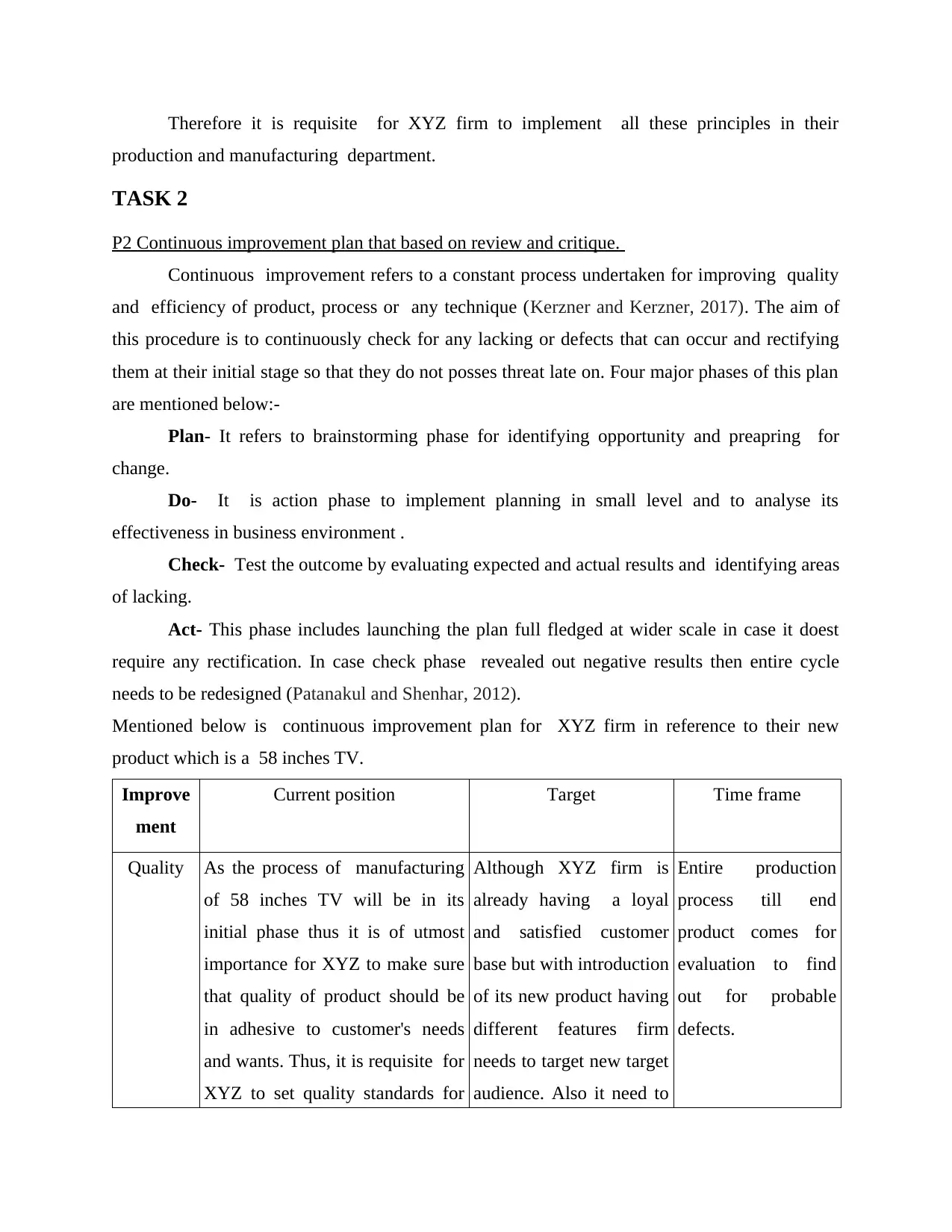
Therefore it is requisite for XYZ firm to implement all these principles in their
production and manufacturing department.
TASK 2
P2 Continuous improvement plan that based on review and critique.
Continuous improvement refers to a constant process undertaken for improving quality
and efficiency of product, process or any technique (Kerzner and Kerzner, 2017). The aim of
this procedure is to continuously check for any lacking or defects that can occur and rectifying
them at their initial stage so that they do not posses threat late on. Four major phases of this plan
are mentioned below:-
Plan- It refers to brainstorming phase for identifying opportunity and preapring for
change.
Do- It is action phase to implement planning in small level and to analyse its
effectiveness in business environment .
Check- Test the outcome by evaluating expected and actual results and identifying areas
of lacking.
Act- This phase includes launching the plan full fledged at wider scale in case it doest
require any rectification. In case check phase revealed out negative results then entire cycle
needs to be redesigned (Patanakul and Shenhar, 2012).
Mentioned below is continuous improvement plan for XYZ firm in reference to their new
product which is a 58 inches TV.
Improve
ment
Current position Target Time frame
Quality As the process of manufacturing
of 58 inches TV will be in its
initial phase thus it is of utmost
importance for XYZ to make sure
that quality of product should be
in adhesive to customer's needs
and wants. Thus, it is requisite for
XYZ to set quality standards for
Although XYZ firm is
already having a loyal
and satisfied customer
base but with introduction
of its new product having
different features firm
needs to target new target
audience. Also it need to
Entire production
process till end
product comes for
evaluation to find
out for probable
defects.
production and manufacturing department.
TASK 2
P2 Continuous improvement plan that based on review and critique.
Continuous improvement refers to a constant process undertaken for improving quality
and efficiency of product, process or any technique (Kerzner and Kerzner, 2017). The aim of
this procedure is to continuously check for any lacking or defects that can occur and rectifying
them at their initial stage so that they do not posses threat late on. Four major phases of this plan
are mentioned below:-
Plan- It refers to brainstorming phase for identifying opportunity and preapring for
change.
Do- It is action phase to implement planning in small level and to analyse its
effectiveness in business environment .
Check- Test the outcome by evaluating expected and actual results and identifying areas
of lacking.
Act- This phase includes launching the plan full fledged at wider scale in case it doest
require any rectification. In case check phase revealed out negative results then entire cycle
needs to be redesigned (Patanakul and Shenhar, 2012).
Mentioned below is continuous improvement plan for XYZ firm in reference to their new
product which is a 58 inches TV.
Improve
ment
Current position Target Time frame
Quality As the process of manufacturing
of 58 inches TV will be in its
initial phase thus it is of utmost
importance for XYZ to make sure
that quality of product should be
in adhesive to customer's needs
and wants. Thus, it is requisite for
XYZ to set quality standards for
Although XYZ firm is
already having a loyal
and satisfied customer
base but with introduction
of its new product having
different features firm
needs to target new target
audience. Also it need to
Entire production
process till end
product comes for
evaluation to find
out for probable
defects.
Paraphrase This Document
Need a fresh take? Get an instant paraphrase of this document with our AI Paraphraser
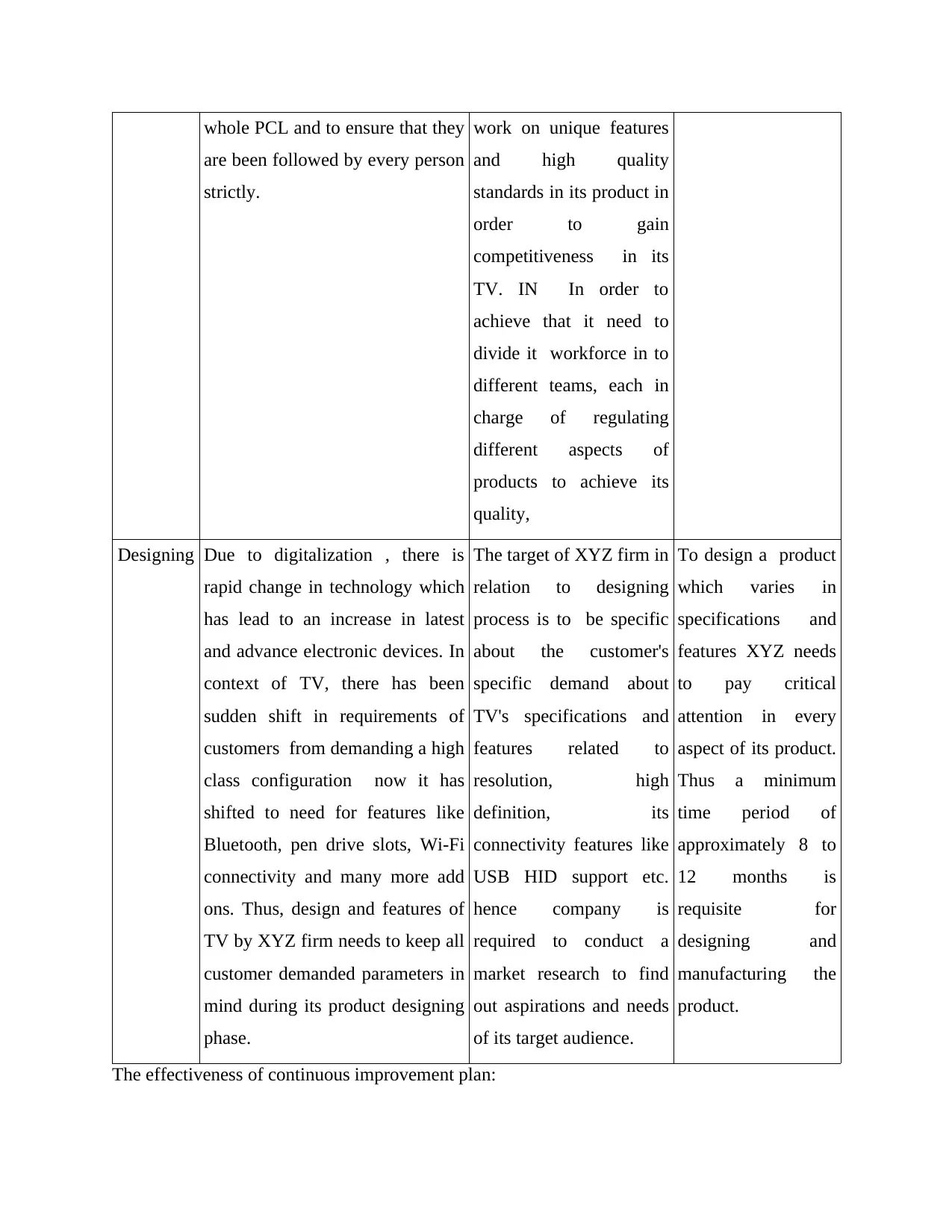
whole PCL and to ensure that they
are been followed by every person
strictly.
work on unique features
and high quality
standards in its product in
order to gain
competitiveness in its
TV. IN In order to
achieve that it need to
divide it workforce in to
different teams, each in
charge of regulating
different aspects of
products to achieve its
quality,
Designing Due to digitalization , there is
rapid change in technology which
has lead to an increase in latest
and advance electronic devices. In
context of TV, there has been
sudden shift in requirements of
customers from demanding a high
class configuration now it has
shifted to need for features like
Bluetooth, pen drive slots, Wi-Fi
connectivity and many more add
ons. Thus, design and features of
TV by XYZ firm needs to keep all
customer demanded parameters in
mind during its product designing
phase.
The target of XYZ firm in
relation to designing
process is to be specific
about the customer's
specific demand about
TV's specifications and
features related to
resolution, high
definition, its
connectivity features like
USB HID support etc.
hence company is
required to conduct a
market research to find
out aspirations and needs
of its target audience.
To design a product
which varies in
specifications and
features XYZ needs
to pay critical
attention in every
aspect of its product.
Thus a minimum
time period of
approximately 8 to
12 months is
requisite for
designing and
manufacturing the
product.
The effectiveness of continuous improvement plan:
are been followed by every person
strictly.
work on unique features
and high quality
standards in its product in
order to gain
competitiveness in its
TV. IN In order to
achieve that it need to
divide it workforce in to
different teams, each in
charge of regulating
different aspects of
products to achieve its
quality,
Designing Due to digitalization , there is
rapid change in technology which
has lead to an increase in latest
and advance electronic devices. In
context of TV, there has been
sudden shift in requirements of
customers from demanding a high
class configuration now it has
shifted to need for features like
Bluetooth, pen drive slots, Wi-Fi
connectivity and many more add
ons. Thus, design and features of
TV by XYZ firm needs to keep all
customer demanded parameters in
mind during its product designing
phase.
The target of XYZ firm in
relation to designing
process is to be specific
about the customer's
specific demand about
TV's specifications and
features related to
resolution, high
definition, its
connectivity features like
USB HID support etc.
hence company is
required to conduct a
market research to find
out aspirations and needs
of its target audience.
To design a product
which varies in
specifications and
features XYZ needs
to pay critical
attention in every
aspect of its product.
Thus a minimum
time period of
approximately 8 to
12 months is
requisite for
designing and
manufacturing the
product.
The effectiveness of continuous improvement plan:
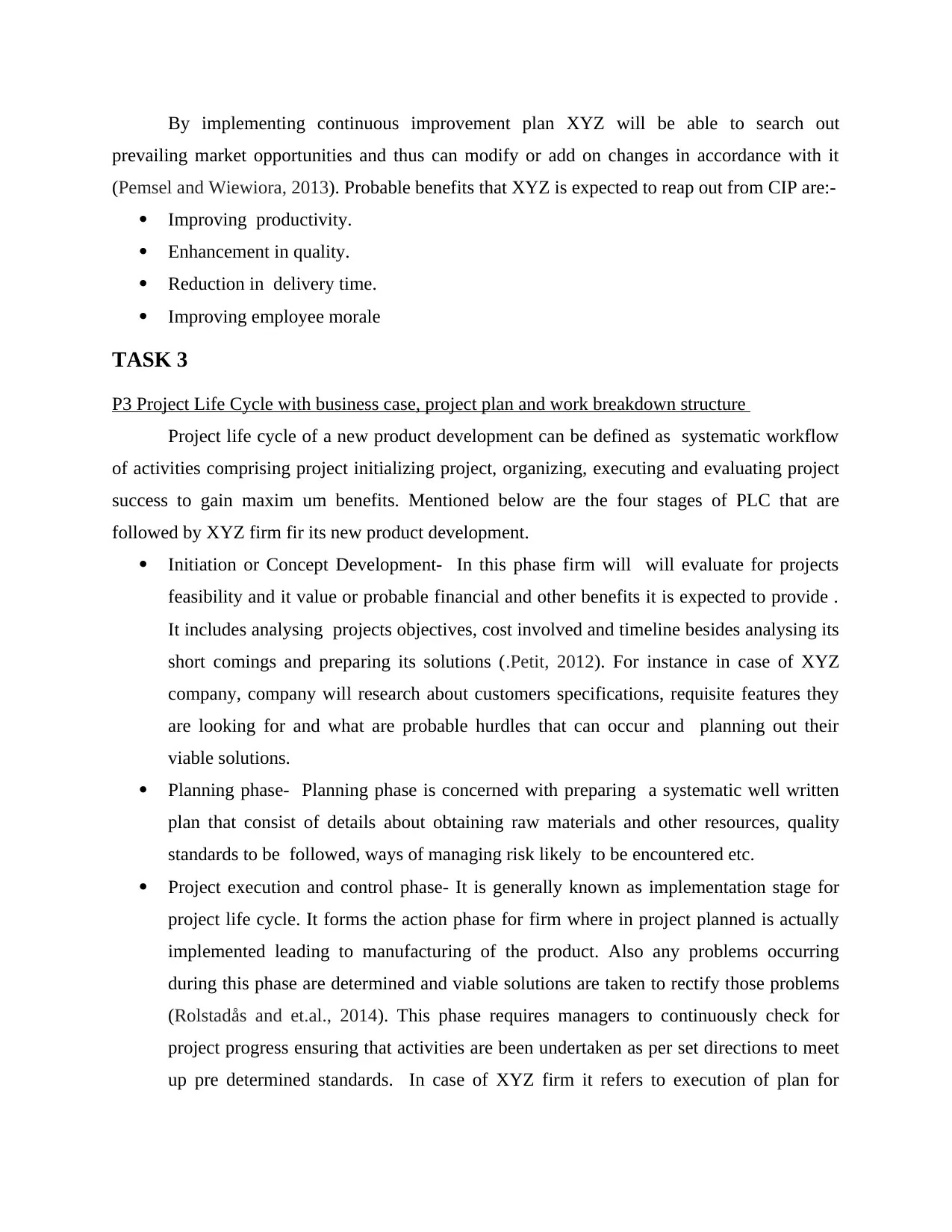
By implementing continuous improvement plan XYZ will be able to search out
prevailing market opportunities and thus can modify or add on changes in accordance with it
(Pemsel and Wiewiora, 2013). Probable benefits that XYZ is expected to reap out from CIP are:-
Improving productivity.
Enhancement in quality.
Reduction in delivery time.
Improving employee morale
TASK 3
P3 Project Life Cycle with business case, project plan and work breakdown structure
Project life cycle of a new product development can be defined as systematic workflow
of activities comprising project initializing project, organizing, executing and evaluating project
success to gain maxim um benefits. Mentioned below are the four stages of PLC that are
followed by XYZ firm fir its new product development.
Initiation or Concept Development- In this phase firm will will evaluate for projects
feasibility and it value or probable financial and other benefits it is expected to provide .
It includes analysing projects objectives, cost involved and timeline besides analysing its
short comings and preparing its solutions (.Petit, 2012). For instance in case of XYZ
company, company will research about customers specifications, requisite features they
are looking for and what are probable hurdles that can occur and planning out their
viable solutions.
Planning phase- Planning phase is concerned with preparing a systematic well written
plan that consist of details about obtaining raw materials and other resources, quality
standards to be followed, ways of managing risk likely to be encountered etc.
Project execution and control phase- It is generally known as implementation stage for
project life cycle. It forms the action phase for firm where in project planned is actually
implemented leading to manufacturing of the product. Also any problems occurring
during this phase are determined and viable solutions are taken to rectify those problems
(Rolstadås and et.al., 2014). This phase requires managers to continuously check for
project progress ensuring that activities are been undertaken as per set directions to meet
up pre determined standards. In case of XYZ firm it refers to execution of plan for
prevailing market opportunities and thus can modify or add on changes in accordance with it
(Pemsel and Wiewiora, 2013). Probable benefits that XYZ is expected to reap out from CIP are:-
Improving productivity.
Enhancement in quality.
Reduction in delivery time.
Improving employee morale
TASK 3
P3 Project Life Cycle with business case, project plan and work breakdown structure
Project life cycle of a new product development can be defined as systematic workflow
of activities comprising project initializing project, organizing, executing and evaluating project
success to gain maxim um benefits. Mentioned below are the four stages of PLC that are
followed by XYZ firm fir its new product development.
Initiation or Concept Development- In this phase firm will will evaluate for projects
feasibility and it value or probable financial and other benefits it is expected to provide .
It includes analysing projects objectives, cost involved and timeline besides analysing its
short comings and preparing its solutions (.Petit, 2012). For instance in case of XYZ
company, company will research about customers specifications, requisite features they
are looking for and what are probable hurdles that can occur and planning out their
viable solutions.
Planning phase- Planning phase is concerned with preparing a systematic well written
plan that consist of details about obtaining raw materials and other resources, quality
standards to be followed, ways of managing risk likely to be encountered etc.
Project execution and control phase- It is generally known as implementation stage for
project life cycle. It forms the action phase for firm where in project planned is actually
implemented leading to manufacturing of the product. Also any problems occurring
during this phase are determined and viable solutions are taken to rectify those problems
(Rolstadås and et.al., 2014). This phase requires managers to continuously check for
project progress ensuring that activities are been undertaken as per set directions to meet
up pre determined standards. In case of XYZ firm it refers to execution of plan for
⊘ This is a preview!⊘
Do you want full access?
Subscribe today to unlock all pages.

Trusted by 1+ million students worldwide
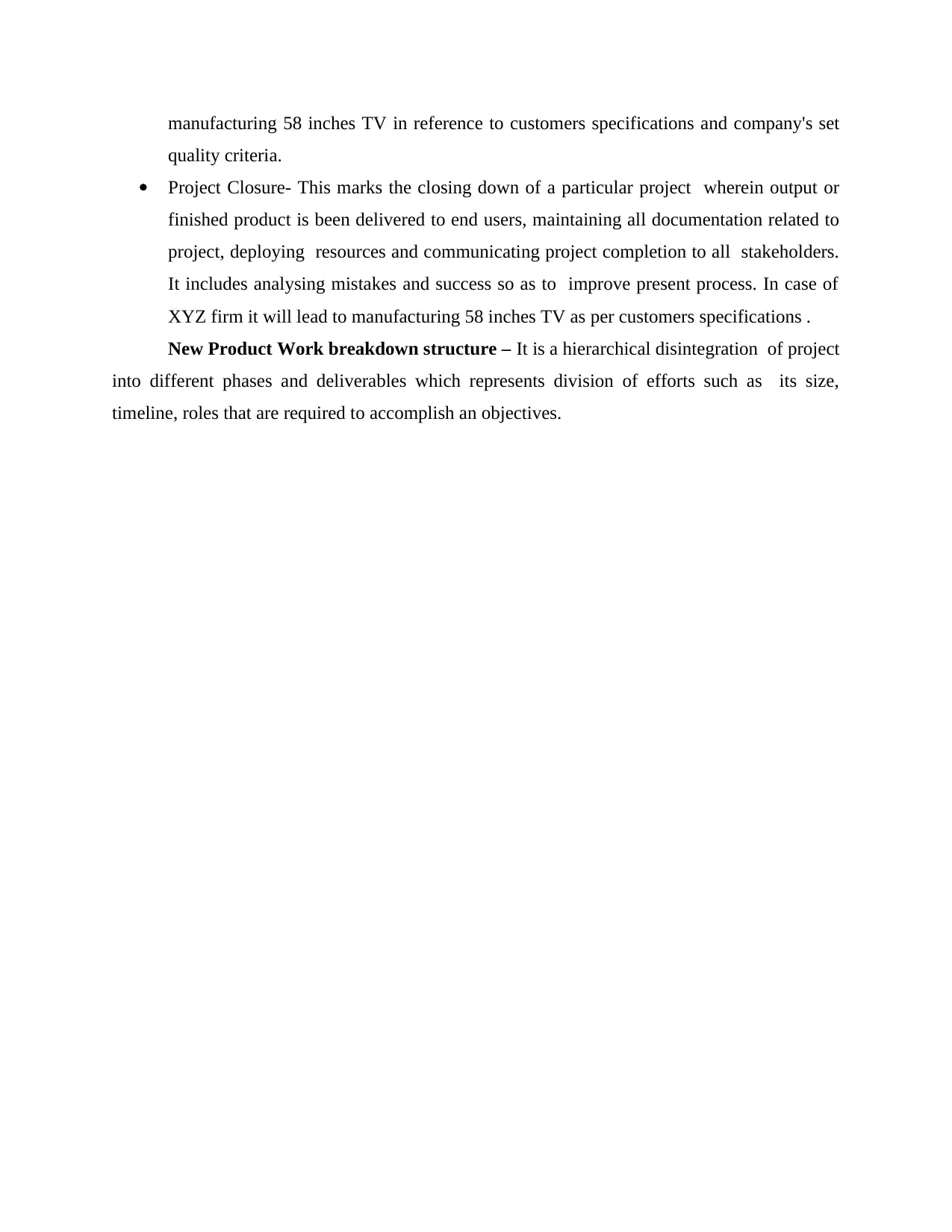
manufacturing 58 inches TV in reference to customers specifications and company's set
quality criteria.
Project Closure- This marks the closing down of a particular project wherein output or
finished product is been delivered to end users, maintaining all documentation related to
project, deploying resources and communicating project completion to all stakeholders.
It includes analysing mistakes and success so as to improve present process. In case of
XYZ firm it will lead to manufacturing 58 inches TV as per customers specifications .
New Product Work breakdown structure – It is a hierarchical disintegration of project
into different phases and deliverables which represents division of efforts such as its size,
timeline, roles that are required to accomplish an objectives.
quality criteria.
Project Closure- This marks the closing down of a particular project wherein output or
finished product is been delivered to end users, maintaining all documentation related to
project, deploying resources and communicating project completion to all stakeholders.
It includes analysing mistakes and success so as to improve present process. In case of
XYZ firm it will lead to manufacturing 58 inches TV as per customers specifications .
New Product Work breakdown structure – It is a hierarchical disintegration of project
into different phases and deliverables which represents division of efforts such as its size,
timeline, roles that are required to accomplish an objectives.
Paraphrase This Document
Need a fresh take? Get an instant paraphrase of this document with our AI Paraphraser
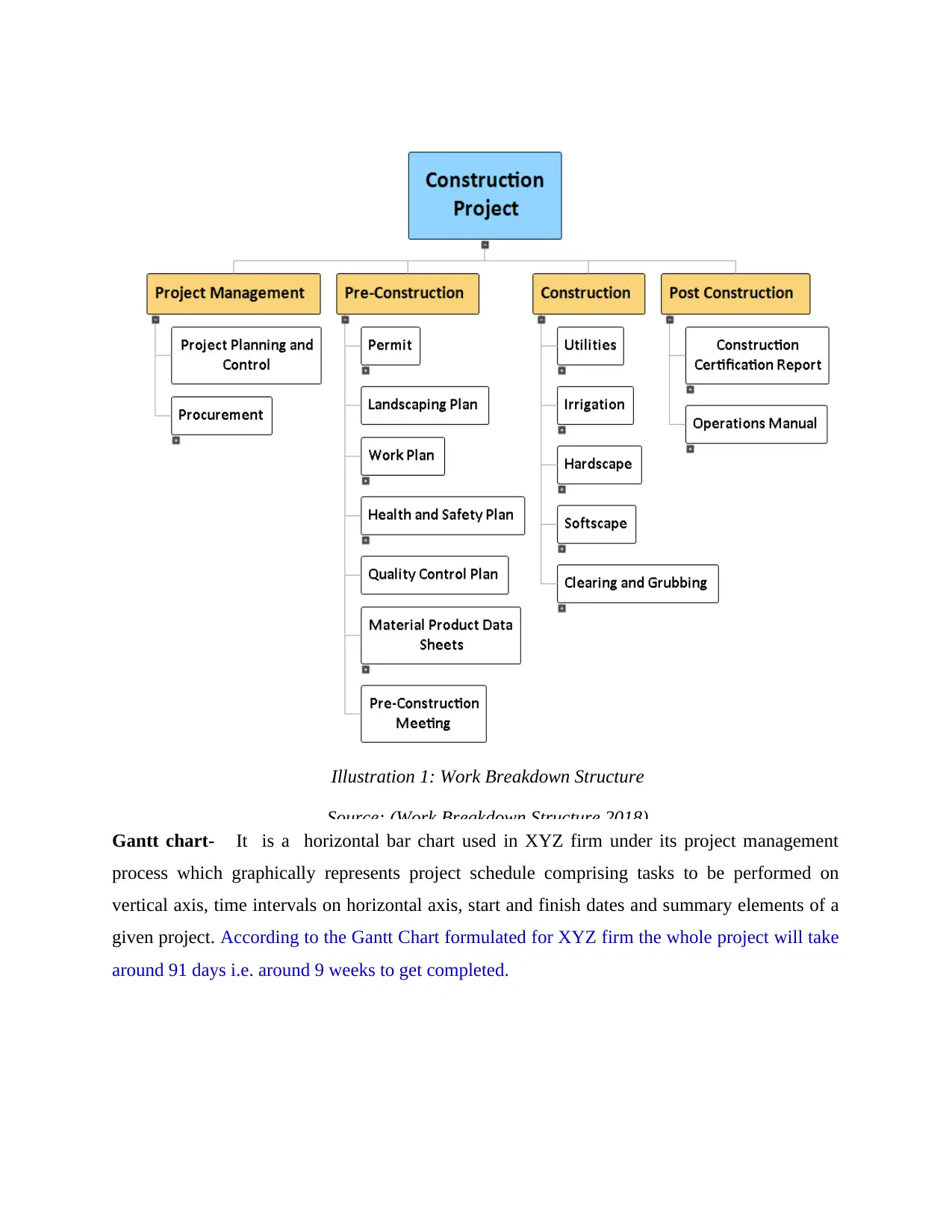
Gantt chart- It is a horizontal bar chart used in XYZ firm under its project management
process which graphically represents project schedule comprising tasks to be performed on
vertical axis, time intervals on horizontal axis, start and finish dates and summary elements of a
given project. According to the Gantt Chart formulated for XYZ firm the whole project will take
around 91 days i.e. around 9 weeks to get completed.
Illustration 1: Work Breakdown Structure
Source: (Work Breakdown Structure,2018)
process which graphically represents project schedule comprising tasks to be performed on
vertical axis, time intervals on horizontal axis, start and finish dates and summary elements of a
given project. According to the Gantt Chart formulated for XYZ firm the whole project will take
around 91 days i.e. around 9 weeks to get completed.
Illustration 1: Work Breakdown Structure
Source: (Work Breakdown Structure,2018)
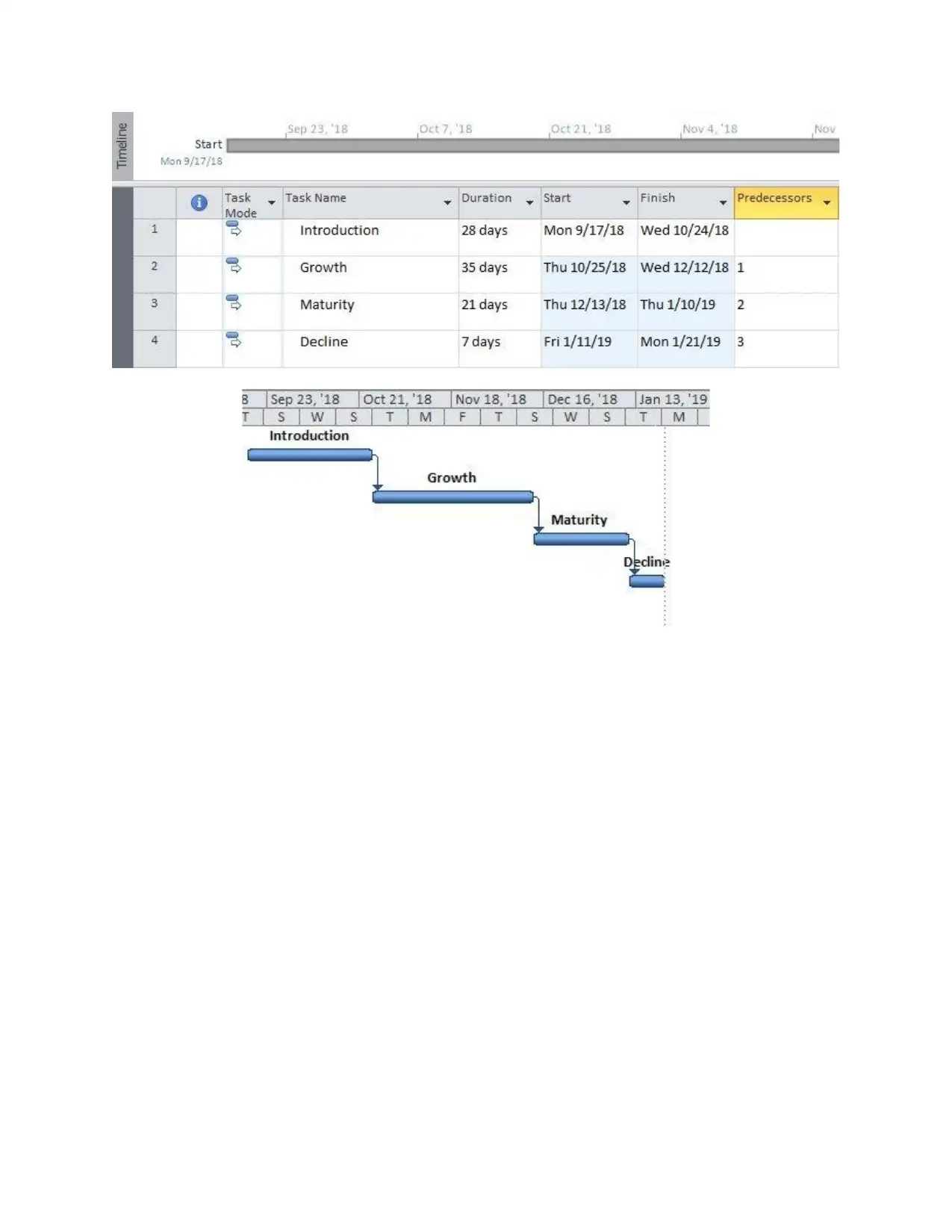
⊘ This is a preview!⊘
Do you want full access?
Subscribe today to unlock all pages.

Trusted by 1+ million students worldwide
1 out of 15
Related Documents
Your All-in-One AI-Powered Toolkit for Academic Success.
+13062052269
info@desklib.com
Available 24*7 on WhatsApp / Email
![[object Object]](/_next/static/media/star-bottom.7253800d.svg)
Unlock your academic potential
Copyright © 2020–2025 A2Z Services. All Rights Reserved. Developed and managed by ZUCOL.





